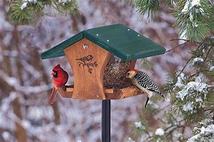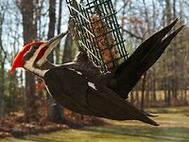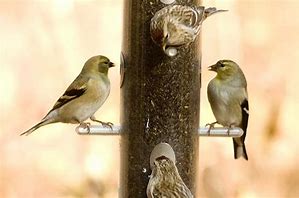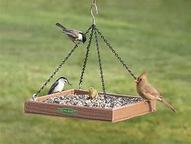Feed the Birds
Varieties of seed, suet and other foods can help attract different types of birds to your backyard. In general, seed mixtures that contain red millet, oats, and other “fillers” are not attractive to most birds and can lead to a lot of waste as the birds sort through the mix.
Make your own Suet
With this easy vegetarian recipe, you can attract insect lovers like woodpeckers and nuthatches.
With this vegetarian version of suet (traditionally it's made from rendered animal fat) you can provide the perfect winter substitute for birds that normally feast on insects. This lipid-rich treat can help prepare year-round residents for the long winter and is quite the draw for birds such as woodpeckers, wrens, chickadees, nuthatches, and titmice. Check out this recipe, inspired by "The Misfit Baker" blog.
Materials:• 1 1/2 cups shortening (look for palm oil free options)
• 3/4 cups nut butter (any kind)
• 3 1/2 cups wild bird seed
• 1 cup quick oats
• 1/2 cup corn meal
• Ice cube tray
Steps:1. Mix the dry ingredients of bird seed, oats, and corn meal together and set aside.
2. Combine the shortening and nut butter in a separate bowl and melt. Stir until completely combined.
3. Pour the melted mixture into the dry ingredients and stir until combined.
4. Spoon mixture into the ice cube tray.
5. Freeze for one to two hours and place in your suet feeder!
Note: Not recommended for outdoor temperatures above 50 degrees .
Materials:• 1 1/2 cups shortening (look for palm oil free options)
• 3/4 cups nut butter (any kind)
• 3 1/2 cups wild bird seed
• 1 cup quick oats
• 1/2 cup corn meal
• Ice cube tray
Steps:1. Mix the dry ingredients of bird seed, oats, and corn meal together and set aside.
2. Combine the shortening and nut butter in a separate bowl and melt. Stir until completely combined.
3. Pour the melted mixture into the dry ingredients and stir until combined.
4. Spoon mixture into the ice cube tray.
5. Freeze for one to two hours and place in your suet feeder!
Note: Not recommended for outdoor temperatures above 50 degrees .
Common Bird Seed Types:
|
Sunflower:
There are two kinds of sunflower—black oil and striped. The black oil seeds (“oilers”) have very thin shells, easy for virtually all seed-eating birds to crack open, and the kernels within have a high fat content, extremely valuable for most winter birds. Striped sunflower seeds have a thicker shell, much harder for House Sparrows and blackbirds to crack open. So if you’re inundated with species you’d rather not subsidize at your black oil sunflower, before you do anything else, try switching to striped sunflower. People living in apartments or who have trouble raking up seed shells under their feeders often offer shelled sunflower. Many birds love this, as of course do squirrels, and it’s expensive. Without the protection of the shell, sunflower hearts and chips quickly spoil, and can harbor dangerous bacteria, so it’s important to offer no more than can be eaten in a day or two. Sunflower is very attractive to squirrels, a problem for people who don’t wish to subsidize them. Some kinds of squirrel baffles, and some specialized feeders, are fairly good at excluding them. Sunflower in the shell can be offered in a wide variety of feeders, including trays, tube feeders, hoppers, and acrylic window feeders. Sunflower hearts and chips shouldn’t be offered in tube feeders where moisture can collect. Cracked Corn:
Corn is eaten by grouse, pheasants, turkeys, quails, cardinals, grosbeaks, crows, ravens, jays, doves, ducks, cranes, and other species. Unfortunately, corn has two serious problems. First, it’s a favorite of House Sparrows, cowbirds, starlings, geese, bears, raccoons, and deer—none of which should be subsidized by us. Second, corn is the bird food most likely to be contaminated with aflatoxins, which are extremely toxic even at low levels. Never buy corn in plastic bags, never allow it to get wet, never offer it in amounts that can’t be consumed in a day during rainy or very humid weather, and be conscientious about raking up old corn. Never offer corn covered in a red dye. Corn intended for planting is often treated with fungicides, marked with red dye as a warning. It is highly toxic to humans, livestock, and all birds. Never offer buttered popcorn or any kind of microwave popcorn. Popped corn spoils quickly. Corn should be offered in fairly small amounts at a time on tray feeders. Don’t offer it in tube feeders that could harbor moisture. Common bird seed and other bird feeding options
was supplied by: The Cornell Lab of Ornithology. |
Safflower:
Safflower has a thick shell, hard for some birds to crack open, but is a favorite among cardinals. Some grosbeaks, chickadees, doves, and native sparrows also eat it. According to some sources, House Sparrows, European Starlings, and squirrels don’t like safflower, but in some areas seem to have developed a taste for it. Cardinals and grosbeaks tend to prefer tray and hopper feeders, which makes these feeders a good choice for offering safflower. Thistle:
Small finches including American Goldfinches, Lesser Goldfinches, Indigo Buntings, Pine Siskins, and Common Redpolls often devour these tiny, black, needle-like seeds. As invasive thistle plants became a recognized problem in North America, suppliers shifted to a daisy-like plant, known as Guizotia abyssinica, that produces a similar type of small, oily, rich seed. The plant is now known as nyjer, and is imported from overseas. The seeds are heat-sterilized during importation to limit their chance of spreading while retaining their food value. White Proso Millet:
White millet is a favorite with ground-feeding birds including quails, native American sparrows, doves, towhees, juncos, and cardinals. Unfortunately it’s also a favorite with cowbirds and other blackbirds and House Sparrows, which are already subsidized by human activities and supported at unnaturally high population levels by current agricultural practices and habitat changes. When these species are present, it’s wisest to not use millet; virtually all the birds that like it are equally attracted to black oil sunflower. Because white millet is so preferred by ground-feeding birds, it’s often scattered on the ground—an excellent practice as long as no more is set out than birds can eat in a day. Low-set tray feeders with excellent drainage can be a very good choice for white millet, too. Peanuts:
Peanuts are very popular with jays, crows, chickadees, titmice, woodpeckers, and many other species, but are also favored by squirrels, bears, raccoons, and other animals that should not be subsidized. Like corn, peanuts have a high likelihood of harboring aflatoxins, so must be kept dry and used up fairly quickly. Peanuts in the shell can be set out on platform feeders or right on a deck railing or window feeder as a special treat for jays, if they reach them before the squirrels do. If peanuts or mixtures of peanuts and other seeds are offered in tube feeders, make sure to change the seed frequently, especially during rainy or humid weather, completely emptying out and cleaning the tube every time. |
Other Bird Feeding Options:
|
Suet:
Suet is technically defined as the hard fat around the kidneys and loins in beef and mutton, but in common usage, most kinds of beef fat are also called suet and can safely be fed to birds. Suet is particularly attractive to woodpeckers, nuthatches, chickadees, jays, and starlings. Wrens, creepers, kinglets, and even cardinals and some warblers occasionally visit suet feeders. Animal fat is easily digested and metabolized by many birds; it’s a high-energy food, especially valuable in cold weather. Raw suet grows rancid quickly when temperatures are above freezing; don’t offer that except in winter. When suet is melted and the impurities removed (“rendering”), it keeps much better, but can still get soft during warm weather. When suet gets soft, it can coat belly feathers, a dangerous situation especially in spring and summer when birds are incubating—tiny pores on the birds’ eggs may get clogged, preventing the developing embryo from getting enough oxygen. Suet cakes are blocks made from suet or a thick substitute mixed with other ingredients, such as corn meal, peanuts, fruits, or even dried insects. Because corn and peanuts can provide a growth medium for dangerous bacteria, it’s important for you to make your own suet cakes or to buy them from reputable dealers. It may be prudent to keep suet cakes made with corn, cornmeal, or peanuts refrigerated until using. Starlings are very fond of suet. To dissuade them, offer suet in a feeder that requires birds to feed hanging upside down. Woodpeckers, chickadees, and nuthatches will access it easily, but starlings cannot. Mealworms:
Mealworms are larvae of a flightless insect called the darkling beetle. They’re a serious pest in granaries, but are safe and easy to maintain in our houses, confined in buckets or plastic bins. Mealworms can be an excellent source of protein, calcium, and vitamins for a great many birds, including some that normally don’t visit feeders, but mealworms are only as healthful as the diet they are fed. If you order them in bulk, they usually come packaged in wads of newspaper, and will eat the paper, ink and all. So make sure to remove them from the paper as quickly as possible when they arrive. It can be tricky to remove them from their packaging—it’s easiest to avoid setting them free in your house if you transfer them from the packaging to your buckets outdoors, or over a very large piece of white paper so you can spot any runaway mealworms before they get far. They don’t live long away from an easy supply of food, but few people relish the thought of them, dead or alive, in crevices in their homes. To maintain a large number of mealworms, fill the bottom of an ice cream bucket, dishpan, or similar bin with an inch or two of dry oatmeal or wheat bran. Add chunks of raw potato or apple for moisture, and then put the mealworms in. To improve the levels of many nutrients, especially during the nesting season, you can add powdered hand-feeding bird food (the kind marketed as a complete diet for hand-reared baby parrots). Mealworms can’t escape a plastic enclosure such as a bucket as long as there are at least two or three inches of vertical wall between the surface of the medium and the lip. Keep them in the coolest place in your house—usually a basement is a great choice—on a surface where the bucket won’t easily get knocked over. There’s a lot of excellent information about mealworms on the North American Bluebird Society website and about how to raise them on the Sialis website. So very many birds will voraciously gobble up mealworms at feeders that offering them is only affordable if you set out a few at a time, at feeders inaccessible to birds you don’t want to subsidize. Small acrylic window feeders work well; if yours has drainage holes, make sure to plug them because mealworms can squeeze through surprisingly tiny spaces. |
Peanut Butter:
In winter, especially in cold climates, peanut butter is a nutritious food to offer birds. Peanut butter sold in grocery stores is certified safe for human consumption, and is safe to offer birds when cold or cool temperatures keep it fairly hard. In warmer weather it must not be kept outside long enough to become rancid or soft. There is some concern that soft peanut butter can stick to birds’ mouths. To make it grittier, cornmeal can be added, but because both corn and peanuts provide excellent media for bacterial and fungal growth, make sure peanut butter feeders are cleaned out frequently. Peanut oils can separate in both pure peanut butter and in mixtures. If these oils adhere to a nesting bird’s feathers, they can be transferred to eggs, plugging the pores, so never provide peanut butter mixtures that become soft or oily. Grit and Minerals:
Eggshells are an excellent source of grit and calcium, but chicken eggs may harbor the salmonella bacteria. Shells from hard-boiled eggs were sterilized in the cooking process, but if you provide eggshells that weren’t cooked, bake them for 20 minutes at 250 degrees Fahrenheit, let them cool, and then crush them into pieces smaller than a dime. Offer eggshells on the ground, in a dish, or on a low platform feeder, separate from your seed feeders. Fruits:
In the tropics, many people set out fruit for birds, attracting a large number of tanagers and other species that people in North America seldom consider “feeder birds.” But even in the north, robins, thrushes, waxwings, bluebirds, mockingbirds, catbirds, and tanagers can sometimes be attracted to feeders providing fruit. Because few people in the United States or Canada offer fruit at feeders, few individuals of these species have experience eating at feeders, so it can be tricky to entice them to get close enough to figure out the concept. Fresh berries; chunks of fresh apples, melons, or grapes; or frozen berries, are excellent choices. Raisins or currants that have been softened by soaking in water may also be good. Orange halves are particularly attractive during spring migration, especially to orioles. Providing fruits can cause some serious problems. It spoils quickly, so feeders must be emptied and cleaned very frequently. Offering fruit in a plastic cereal bowl makes this an easier task. Unfortunately, in summer, fruit attracts ants and wasps; fortunately, there’s no compelling reason to feed fruit in summer and fall when so much fresh fruit is available naturally. Pumpkin seeds and other squash or melon seeds can be extremely attractive for birds. Bake them or spread them out to dry completely, and then run them through a food processor to chop them up, which will make them easier for smaller birds to eat. Water:
Always remember, birds need water year round! |
For more information about attracting wildlife,
go to the BBC Wildlife Sanctuary's
Attracting Wildlife Page
go to the BBC Wildlife Sanctuary's
Attracting Wildlife Page




